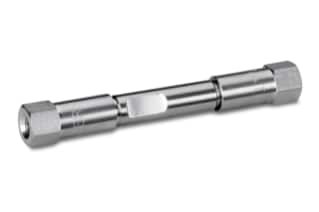
|
Chemistry |
C18 |
|
Separation Mode |
Reversed Phase |
|
Particle Substrate |
Silica |
|
pH Range Min |
3 pH |
|
pH Range Max |
7 pH |
|
Maximum Pressure |
6000 psi (415 Bar) |
|
Endcapped |
Yes |
|
Bonding Technology |
dC18 |
|
Silanol Activity |
Medium |
|
Particle Shape |
Spherical |
|
Particle Size |
5 µm |
|
Endfitting Type |
Waters |
|
Pore Size |
100 Å |
|
Format |
Column |
|
Surface Area |
330 |
|
System |
HPLC |
|
USP Classification |
L1 |
|
Inner Diameter |
4.6 mm |
|
Length |
50 mm |
|
Carbon Load |
12 % |
|
UNSPSC |
41115709 |
|
Brand |
Atlantis |
|
Product Type |
Columns |
|
Units per Package |
1 pk |
Atlantis dC18 Column, 100Å, 5 µm, 4.6 mm X 50 mm, 1/pk
Atlantis dC18 columns are universal reversed-phase C18 columns made of silica that are used for polar compound retention. The di-functionally bonded C18 ligands in the Atlantis dC18 columns have been optimized for use with highly aqueous mobile phases, including 100% water.
The Atlantis dC18 Column is aqueous mobile phase compatible and has improved pH stability. This equipment's carefully designed packing material, which offers retention and separation of polar, water-soluble chemicals, makes the silica-based, di-functionally bonded C18 material an ideal piece of lab equipment for reversed-phase HPLC.
For better peak form, low pH stability, improved polar compound retention, and resistance to hydrophobic collapse, the Atlantis dC18 Column combines optimized stationary phase features like end-capping, silica pore size, ligand type, and bonded phase ligand density (dewetting). As one of the best reversed-phase HPLC columns, the Atlantis dC18 Column is suitable for both polar compound separation and typical reversed-phase applications. In addition to a longer column lifetime and low pH stability, the Atlantis dC18 column's di-functional silane bonding chemistry also offers good stability under acidic mobile conditions.
All of our lab equipment is manufactured under strict conditions and subjected to stringent quality assurance standards, ensuring that you only receive high-quality products from your lab. We provide a variety of brands and versions that have been specifically designed to meet the needs of every type of chromatographic analysis. To learn more about the Atlantis dC18 Column variations or to find the complete catalog of Waters offerings, visit our shop for lab equipment; you can browse our website, refer to our catalog, and ensure your lab needs are met as needed.
We also highly recommend you check out Atlantis Silica dC18 VanGuard Cartridge, 100Å, 5 µm, 3.9 mm X 5 mm, 3/pk; Atlantis dC18 VanGuard Cartridges are used to extend the lifetime and performance of analytical columns by removing particulate contamination from the mobile phase stream. This cartridge is designed to protect all Atlantis dC18 analytical columns with 3.9 mm and 4.6 mm I.D. and 5 µm sorbent particles.
What Is Chromatography Sensitivity?
Sensitivity, for example, is the slope of a linear calibration curve, which measures the signal output per unit concentration or mass of a substance entering the detector from the mobile phase. For concentration-sensitive detectors, sensitivity is also defined as the ratio of peak height to analyte concentration in the peak. In mass-flow sensitive detectors, it is the peak height to unit mass ratio.